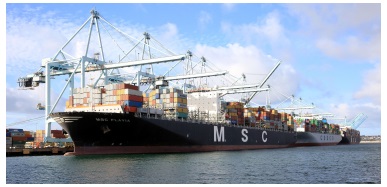
| March 24, 2015 | |
Cargo Operations: Duluth/Superior, Georgia, Jacksonville, Los Angeles
![]() Print this Article | Send to Colleague
Print this Article | Send to Colleague
2015 Shipping Season Gets Underway at the Port of Duluth/Superior
The March 23 sailing of two U.S.-flag Laker ships from the Port of Duluth/Superior signaled the start of the 2015 commercial shipping season at this end of the Great Lakes St. Lawrence Seaway system.
On Sunday morning, the John G. Munson, with an assist from Heritage Marine tugs, moved from its winter berth at Fraser Shipyards in Superior to first fuel at the Port Terminal then shifted over to the CN Duluth Dock to load 24,000 short tons of iron ore pellets. On Monday afternoon, it sailed beneath the Aerial Bridge, destined for Gary, Indiana.
Later that day, the Mesabi Miner cast off from the Superior Midwest Energy Terminal with some 57,000 tons of coal onboard for the power plant at Taconite Harbor. After making that delivery, the 1,000-footer returned to the Twin Ports for a couple of days of scheduled maintenance work and to load its next coal cargo.
While Lake Superior looks bright blue in the early spring sunshine here in Duluth-Superior, there is still a significant amount of ice cover on the eastern edge of the Lake – two to three feet thick from Whitefish Point to the St. Marys River. As such, U.S. Coast Guard cutter Alder will be working in tandem with USCGC Mackinaw to lay tracks and provide escorts for vessels as needed through that eastern ice pack to and from the Soo Locks.
Munson is expected to be the first downbound commercial vessel in position to transit the Soo Locks between Lake Superior and the Lower Great Lakes this season. Four upbound vessels were waiting below the Soo Locks when they reopened at 12:01 a.m. on Wednesday, March 25 – the Edwin H. Gott, Edgar B. Speer, Roger Blough and the Algoma Olympic.
"Against what seemed like insurmountable odds with everything Mother Nature threw at us from beginning to end, the Port of Duluth-Superior wrapped up the 2014 shipping season a full 2.3 percent ahead of expectations, having moved over 37.5 million short tons of cargo," said Executive Director Vanta Coda, of the Duluth Seaway Port Authority. "There are still some formidable ice challenges along the Great Lakes-Seaway, but nowhere near what the fleets were facing at this same time last year."
Looking ahead, he predicted "a banner year here at the Port Terminal for project cargo moving through Duluth in 2015," including "several shipments of equipment heading in from Europe and elsewhere destined for wind energy installations and oil/gas fields further north and west." Overall, he said: "All told, the Port of Duluth-Superior should see a two percent increase in activity during 2015. Headwinds do exist in the decline of commodity pricing (e.g. iron ore and oil). And the strengthening U.S. dollar will challenge exports, however import prospects will improve."
Georgia: ZIM Tianjin, Largest vessel to Call Savannah
The Georgia Ports Authority welcomed the largest ship ever to call on the Port of Savannah on March 18 when the ZIM Tianjin docked at Garden City Terminal.
The 10,060 TEU vessel has a length of 1,145 feet/meters, 150 feet/meters, maximum loaded draft of feet/15 meters and deadweight capacity of 116439 metric tons. Tianjin’s voyage originated in Qingdao, China, and continued on to the U.S. East Coast via the Suez Canal.
"The port call by the ZIM Tianjin is another example of the strong and long standing professional relationship between GPA and ZIM," said ZIM Vice President Brian Black. "We are very excited to have the largest vessel call Savannah!"
GPA crews made more than 2,000 container moves on and off the ship during its time in Savannah.
GPA Executive Director Curtis Foltz said ships in the Tianjin's class provide lower cost per container slot for cargo owners -- reducing the expense of delivering goods to customers at home and abroad. "The economy of scale achieved by Super Post-Panamax vessels is the reason we're seeing more of them in Savannah, a trend that will only continue after an expanded Panama Canal opens in 2016."
To better accommodate Super Post-Panamax vessels, the Savannah Harbor Expansion Project will deepen the main river channel to 47 feet at low tide (averaging 54 feet at high tide). This month, the U.S. Army Corps of Engineers issued a $134.5 million contract that will mark the start of dredging (Advisory, March 10, 2014). The contract covers deepening the outer harbor, extending 18.5 miles into the Atlantic Ocean.
Tianjin's next scheduled stop was Kingston, Jamaica.

The ZIM Tianjin sails past Savannah's historic downtown on the way to the Georgia Ports Authority’s Garden City Terminal on March 18, 2015. The 10,060-TEU vessel is the largest container ship to call on the Port of Savannah.
Photo/ Stephen B. Morton/GPA
U.S. Military Moves 51 Specialty Aircraft through JAXPORT
The U.S. military landed 48 specialty Army helicopters and three Air Force helicopters at the Jacksonville Port Authority’s Blount Island Marine Terminal during a multi-day operation earlier this month. The aircraft shipments were handled by the U.S. Army's 832nd Transportation Battalion, which is headquartered at Blount Island.
The Army helicopters, which arrived one at a time from the 101st Airborne Division in Fort Campbell (KY) are being prepared for shipment by ro/ro ship to destinations in Europe. The Air Force helicopters were processed at Blount Island before flying to an Air Force base in Northwest Florida.
The 832nd Transportation Battalion coordinates the movement of Department of Defense cargo through all ports in Florida, Latin America and the Caribbean and employs both military and civilian personnel.
JAXPORT is one of 16 commercial ports and 35 alternates that comprise the National Strategic Port system that can be called upon to move U.S. Defense Department cargo in the event of an international military emergency.

Staging military helicopters at Blount Marine Terminal
Photo/Jacksonville Port Authority
Los Angeles: Triple Play at APM Terminals Pier 400
For the first time ever at a U.S. port, three ultra-large container ships (ULCS) with nominal respective capacities of 13,000 TEUs each, called APM Terminals Pier 400 complex in the Port of Los Angeles, between Feb. 22 and March 7, representing a combined total of 34,465 container moves over the period, including intermodal cargo of 28 double stack trains.
The 13,100 TEU COSCO Harmony, at 367 meters/1,204 feet in length and 48 meters/157 feet wide, operating in COSCO’s South China/U.S. Southwest Coast Express Service (SEA) registered 10,617 container moves. Two Mediterranean Shipping Company vessels, the 12,991 TEU MSC Flavia, at 366.5 meters long/1,200 and 48 meters wide/157 feet, and the 13,119 TEU MSC Renee, 366.4 meters/1,200 feet long and 48.2 meters/158 feet wide, were also alongside at the quay, accounting for 12,402 and 11,446 moves, respectively. MSC Renee and MSC Flavia both operate as part of the 2M alliance between Mediterranean Shipping and Maersk Line in the Far East/U.S. West Coast trade lane.
"Our facility handled the first 13,000 TEU vessel to call the port of Los Angeles last summer, and now with three calling at once we have shown that we are more than able to keep pace with the changes in our industry, and the needs of our shipping line customers" said APM Terminals Pier 400, Managing Director, Steven Trombley.
At 484 acres, APM Terminals Pier 400, which opened in 2002, is the largest single proprietary terminal in the world. The 40-acre on-dock rail facility and five miles of working track can accommodate four double stack trains simultaneously. The three ULCS container movements included cargo loading for 13 double stack trains from the MSC Renee, nine from the MSC Flavia and six from the COSCO Harmony.
Throughput at APM Terminals Pier 400 was 2.19 million TEUs in 2014. In June 2014, the Los Angeles Board of Harbor Commissioners approved an APM Terminals proposal to raise the facility’s 14 cranes by 32 feet to 304 feet, and extend their booms by 10 feet to 376 feet to accommodate anticipated ULCS traffic.The project is expected to be completed by 2016.
In March 2012 the MSC Fabiola, at 12,562 TEU capacity, became the largest containership to call an American port when it arrived at the Port of Long Beach. In June of 2014, the record was eclipsed by the 13,000 TEU COSCO Development, which called APM Terminals Pier 400 Los Angeles. As ULCS’ of up to 19,224 TEUs are introduced into the Asia/Europe trade, the large vessels previously deployed in those services are being cascaded into the trans-Pacific Asia/USA trade. At present, 265 ULCS of 10,000 TEU capacity or larger are in service, with another 137 on order.

The Ultra-Large Container Ships MSC Flavia, COSCO Harmony, and MSC Renee shown docked at APM Terminals Pier 400 in the Port of Los Angeles.
Photo/APM Terminals
